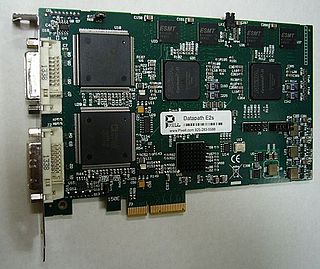
InfiniBand (IB) is a computer networking communications standard used in high-performance computing that features very high throughput and very low latency. It is used for data interconnect both among and within computers. InfiniBand is also used as either a direct or switched interconnect between servers and storage systems, as well as an interconnect between storage systems. It is designed to be scalable and uses a switched fabric network topology. Between 2014 and June 2016, it was the most commonly used interconnect in the TOP500 list of supercomputers.

Low-voltage differential signaling (LVDS), also known as TIA/EIA-644, is a technical standard that specifies electrical characteristics of a differential, serial signaling standard. LVDS operates at low power and can run at very high speeds using inexpensive twisted-pair copper cables. LVDS is a physical layer specification only; many data communication standards and applications use it and add a data link layer as defined in the OSI model on top of it.

Machine vision is the technology and methods used to provide imaging-based automatic inspection and analysis for such applications as automatic inspection, process control, and robot guidance, usually in industry. Machine vision refers to many technologies, software and hardware products, integrated systems, actions, methods and expertise. Machine vision as a systems engineering discipline can be considered distinct from computer vision, a form of computer science. It attempts to integrate existing technologies in new ways and apply them to solve real world problems. The term is the prevalent one for these functions in industrial automation environments but is also used for these functions in other environment vehicle guidance.

In telecommunication and data transmission, serial communication is the process of sending data one bit at a time, sequentially, over a communication channel or computer bus. This is in contrast to parallel communication, where several bits are sent as a whole, on a link with several parallel channels.

Serial digital interface (SDI) is a family of digital video interfaces first standardized by SMPTE in 1989. For example, ITU-R BT.656 and SMPTE 259M define digital video interfaces used for broadcast-grade video. A related standard, known as high-definition serial digital interface (HD-SDI), is standardized in SMPTE 292M; this provides a nominal data rate of 1.485 Gbit/s.

High-Definition Multimedia Interface (HDMI) is a proprietary audio/video interface for transmitting uncompressed video data and compressed or uncompressed digital audio data from a source device, such as a display controller, to a computer monitor, video projector, digital television, or digital audio device. HDMI is a digital replacement for analog video standards.

DisplayPort (DP) is a proprietary digital display interface developed by a consortium of PC and chip manufacturers and standardized by the Video Electronics Standards Association (VESA). It is primarily used to connect a video source to a display device such as a computer monitor. It can also carry audio, USB, and other forms of data.

A frame grabber is an electronic device that captures individual, digital still frames from an analog video signal or a digital video stream. It is usually employed as a component of a computer vision system, in which video frames are captured in digital form and then displayed, stored, transmitted, analyzed, or combinations of these.

Asynchronous Serial Interface, or ASI, is a method of carrying an MPEG Transport Stream (MPEG-TS) over 75-ohm copper coaxial cable or optical fiber. It is popular in the television industry as a means of transporting broadcast programs from the studio to the final transmission equipment before it reaches viewers sitting at home.
The following are common definitions related to the machine vision field.

Multichannel Audio Digital Interface (MADI) standardized as AES10 by the Audio Engineering Society (AES) defines the data format and electrical characteristics of an interface that carries multiple channels of digital audio. The AES first documented the MADI standard in AES10-1991 and updated it in AES10-2003 and AES10-2008. The MADI standard includes a bit-level description and has features in common with the two-channel AES3 interface.

Twinaxial cabling, or twinax, is a type of cable similar to coaxial cable, but with two inner conductors in a twisted pair instead of one. Due to cost efficiency it is becoming common in modern (2013) very-short-range high-speed differential signaling applications.
Camera Link is a serial communication protocol standard designed for camera interface applications based on the National Semiconductor interface Channel-link. It was designed for the purpose of standardizing scientific and industrial video products including cameras, cables and frame grabbers. The standard is maintained and administered by the Automated Imaging Association or AIA, the global machine vision industry's trade group.
Uncompressed video is digital video that either has never been compressed or was generated by decompressing previously compressed digital video. It is commonly used by video cameras, video monitors, video recording devices, and in video processors that perform functions such as image resizing, image rotation, deinterlacing, and text and graphics overlay. It is conveyed over various types of baseband digital video interfaces, such as HDMI, DVI, DisplayPort and SDI. Standards also exist for the carriage of uncompressed video over computer networks.
GenICam is a generic programming interface for machine vision (industrial) cameras. The goal of the standard is to decouple industrial camera interfaces technology from the user application programming interface (API). GenICam is administered by the European Machine Vision Association (EMVA). The work on the standard began in 2003 and the first module in GenICam, i.e., GenApi, was ratified in 2006 whereas the final module, i.e., GenTL was ratified in 2008.
ARINC 818: Avionics Digital Video Bus (ADVB) is a video interface and protocol standard developed for high bandwidth, low-latency, uncompressed digital video transmission in avionics systems. The standard, which was released in January 2007, has been advanced by ARINC and the aerospace community to meet the stringent needs of high performance digital video. The specification was updated and ARINC 818-2 was released in December 2013, adding a number of new features, including link rates up to 32X fibre channel rates, channel-bonding, switching, field sequential color, bi-directional control and data-only links.
V-by-One HS is an electrical digital signaling standard that can run at faster speeds over inexpensive twisted-pair copper cables than Low-voltage differential signaling, or LVDS. It was originally developed by THine Electronics, Inc. in 2007 for high-definition televisions but since 2010 V-by-One HS has been widely adopted in various markets such as document processing, automotive infotainment systems, industrial cameras and machine vision, robotics and amusement equipments.
Mikrotron GmbH develops, produces, distributes, and rents high-speed cameras, recording systems, software and image processing components. The company, based near Munich, Germany, employs about 35 people, and has 35 distributors operating in over 30 countries.
Gigabit Multimedia Serial Link, commonly referred to as GMSL, is a serial link technology that is used for video distribution in cars. It was developed by Maxim Integrated. Maxim Integrated was acquired by Analog Devices in 2021.












